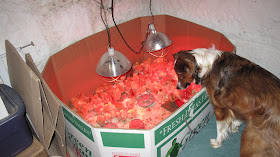I will pass through all thy flock to day, removing from thence all the speckled and spotted cattle, and all the brown cattle among the sheep, and the spotted and speckled among the goats: and of such shall be my hire.
Genesis 30:32
I know why we have animals that look like this:
 Evil-ass tiger at Doc Shepard's place. Does not validate Belyaev's results. This cat scared the crap out of me.
Evil-ass tiger at Doc Shepard's place. Does not validate Belyaev's results. This cat scared the crap out of me.And this:
A lot has been made of the
Belyaev experiments, and how spotting and neotenic features are genetically and biochemically linked to tame behavior. Sure. Fascinating. One of my favorite things that I ever learned about. But there's another route to piebald. Because we monkey-folk, visual foragers in the deepest recesses of our brains, absolutely fixate on
one of these things that's doin' it's own thing...So, my broiler chicks came in the mail Friday morning.
I picked them up at the PO and moved them into the Green Giant potato box in the basement. (Shout out to my homie Ray, who scored me these boxes from his store. Best brooders ever.)

Most chickens raised for meat are industrial hybrid crosses of proprietary inbred parent strains, mutant half-naked obese Frankenchickies that grow to slaughter size in only six weeks, and spontaneously drop dead shortly after that point, if they have managed to stay alive and up on their bloated feet that long.
They look like this:

And mostly what they do, besides grow like mung beans and look for a comfortable place to die, is eat and shit and stink.
After seeing these pathetic creatures at the county fair (4H meat pen class) for years, and reading the descriptions of what it's like to raise them from posters on the Backyard Chickens forum, I really did not want to go there. I'd be embarrassed to have anyone see them on my farm. I'd be ashamed to look at them myself.
But, you know, we don't just like chickens -- we like
chicken. Tastes like chicken, it does.
At the recommendation of several posters on
Backyard Chickens, we got
these.
The colored range broilers, aka "freedom rangers," are also F1 hybrids, and are arguably "industrial," in that the parent strains are not generally available for producers to breed their own. But instead of being selected and "designed" to gain weight at unnatural speeds while protected from the elements and constantly fed, they are selected to grow about half as fast, to forage for themselves on pasture and display normal chicken behavior, all while keeping about the same
feed-conversion ratio as the industrial birds.
They are the same varieties used to grow premium
label rouge poultry in France.
I expect them to be delicious.
Back to domestication, and spotty critters. These guys come in several color morphs -- most of them will be mostly red or yellow feathered, a few will have other colors and patterns. Like many hybrids, they may not resemble either parent. I don't know. I haven't actually seen pictures of the parent strains.
I settled the McNuggets into their brooder, and several hours later my mother went down to visit them.
Overheard her alternately cooing over the box of chicks and arguing on the phone with my brother:
Oh no, these are egg-laying chickens, not eating chickens.
Uh, Mom, these are our meat birds. What would I do with 100 laying hens?
Oh no! I already started naming them! You can't eat Dale!Here's Dale sticking out of the crowd:

Most of the chicks are a fairly uniform yellow or orange. A few have some indistinct darker markings. One has a smudgy dark face, thus named Pigpen. Only Dale has very distinct chipmunk markings. He, or she, stands out in the mass of 100. It's easy to convince oneself that Dale has more personality than the other 99 chicks, more expression, more intelligence.
He gets picked up more often than the other chicks, so unless he has a more flighty-than-average temperament, he's more likely to be friendly and tame.
If one of the plain yellow chicks actually had some unique and charming behavior, how would we know? Is it the same chick every time, or just something that the yellow chicks occasionally do?
So originally, it worked the other way 'round. The mutant yellow chick in the brood of chipmunk-striped ones that grew into a distinctive white or red hen. The puppy with some white on his chest amid the wolf-sable littermates. The calf with the star on her forehead. All got favored treatment for the mere fact that they stuck out of the crowd. Got named Spot or Goldie.
And then got to live long enough to have babies. Because
you can't eat Dale.
Other predators notice difference, flash, spots too. That's probably why an owl took my "lilac" (silver-grey) guinea cock and left the natural-colored "pearl" cock. The lilac bird fairly glowed in the moonlight.
Humans started preserving the flashy animals when we domesticated them, and weren't just aiming our spears at the funny-looking one. We had to be in a position to protect them from other predators, too, a struggle that continues to be more difficult with flashy domesticants.
A species' natural coloring is natural because it works. A domesticated species' unnatural coloring also works, because the guys providing the food and protection fixate on it.
Nevertheless, we will most likely eat Dale.







